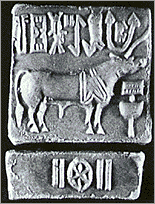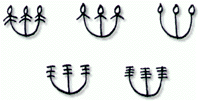
The pictogram just mentioned has several variant forms in the Indus texts (Fig. 16, 17). Their comparison with the motifs of Early Harappan painted pottery (Fig. 7) suggests that this pictogram represents the large Indian fig tree, Ficus Indica.
Except when combined with another sign (depicting the 'crab'), which is placed inside it omitting the central "branch" (Fig. 15), the tree is shown as three-branched (Fig. 16), just as in the painted pottery. In one variant of the combined sign, the branches end in fig leaves as in the painted pottery (Fig. 15), but in other variants the branches seem to bear either fig fruits or hanging aerial roots or both (Fig. 17)
16. (Left) The impression of a seal from Harappa.
 17. (Right) Three-branched "fig tree."
17. (Right) Three-branched "fig tree."
The rope-like hanging aerial roots are characteristic of the Indian fig tree; indeed, it seems that one of the Sanskrit names for this tree, vata, is of Dravidian origin (it is called vatam in a number of Dravidian languages), and that this name is ultimately derived from the Dravidian word vatam 'rope, cord'.
This etymology also appears preferable to the current explanation, which derives vata 'Indian fig' from Middle Indo-Aryan (Prakrit vata Sanskrit vÆta 'covered, surrounded'), because the Aryan nomads did not bring this tree to the subcontinent, but encountered it first there. They could, of course, give this tree an Aryan name: nyag-rodha 'downwards growing' is one, based on the tree's habit of growing new trunks from the hanging aerial roots. But adoption of a tree's earlier native appellation would be an even more natural process.
 18. Fig tree pictogram followed by two vertical strokes and by fish.
18. Fig tree pictogram followed by two vertical strokes and by fish.
The Dravidian explanation of the Indian fig's name vata as 'rope-tree' makes it possible to find a Dravidian homophone eminently fitting the astral context assumed in the Indus texts where the 'fig tree' pictogram is followed by the 'fish' or 'two long vertical strokes' (Fig. 18).
In Dravidian, the word vata also means 'north', and in Old Tamil vata-meen is the name of the North star. This Dravidian homophony, linking vata 'Indian fig' and vata 'north', suggests an earlier Indian background also for the classification of trees found in Sanskrit texts which make the Indian fig the "tree of the northern direction".
Moreover, even as early as in the Rgveda (1,24,7), mention is made of an Indian fig whose roots are kept up in the middle of the sky by the god VaruÜa. Later cosmological descriptions seem to associate this often mentioned heavenly fig tree with the north star; for in reply to the question why do the stars remain in the sky and not fall down, the Pur¿Üas offer an explanation that reminds us of the Indian fig's aerial roots: it is maintained that the stars and planets are fixed to the north star with invisible ropes.
Above, Harappan painted pottery and graphic variants were invoked to justify the pictorial interpretation of the 'Indian fig tree' pictogram. A confirmation of this interpretation is provided by two Indus amulets, one side of which shows nothing but a clearly recognizable fig leaf. The other side shows a short inscription of three pictograms, the middlemost being that read as vata (Fig. 19). Besides the 'single fig leaf' pictogram on the reverse, these amulets offer another contextual proof for the 'Indian fig tree' pictogram.
 19. Inscription on Indus amulet from Harappa
19. Inscription on Indus amulet from Harappa
The last of the three signs (on the left) is not so significant in the inscription on the obverse, since most Indus texts end in it.
But the first sign (on the right), which precedes the 'Indian fig tree' pictogram, is very important for two reasons: first, because it can be assumed to be either an attribute of the word expressed by the 'Indian fig tree' pictogram or the first member of a compound formed with it., and second, because its pictorial shape can be interpreted with minimal ambiguity. There can be no reasonable doubt that this attributive sign represents the numeral 'four' through its four short vertical strokes (Fig. 19). Read in Dravidian, does it make any sense in this context? 'Four' is nal in Dravidian, and there is a closely homophonous Dravidian root nal meaning 'to hang, be suspended', used with special reference to hanging ropes and vines. The compound formed by the two pictograms would mean, then, '(tree characterized by) hanging ropes', as the Indian fig is.
The latter root, nal 'to hang', originally starts with a palatal nasal, but it is assumed that the common alternation between na and na and the loss of the nasal in the initial position in Dravidian languages already existed in Proto-Dravidian. This phonetic alternation not only makes nal 'to hang' fully homophonous with nal 'four', but also makes it possible to suggest here an etymology (i.e. derivation from nal 'to hang; hanging rope') for one of the principal Dravidian names of the Indian fig tree, namely 'al'.4
[Originally published as Parpola, Asko (1988) Religion reflected in the iconic signs of the Indus script: penetrating into long-forgotten picto+graphic messages. Visible Religion 6: pp. 114-135.]
